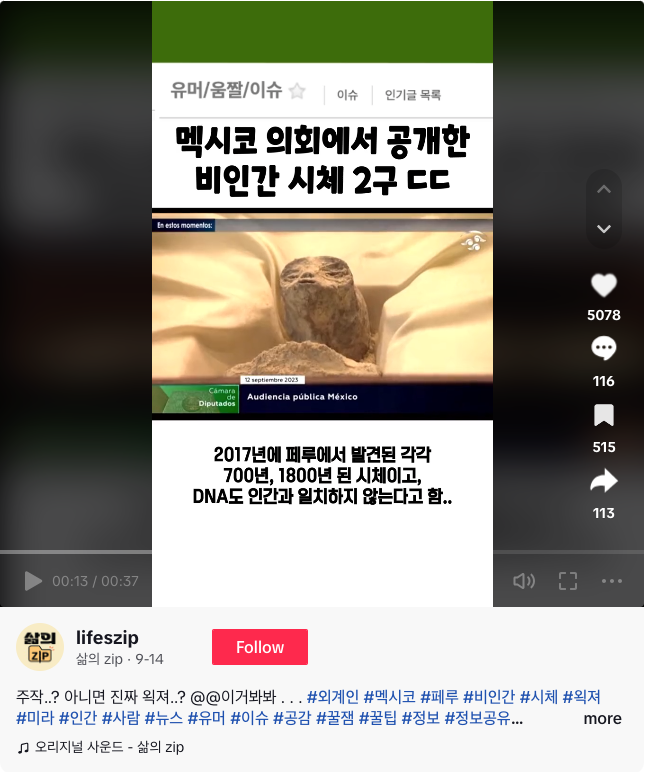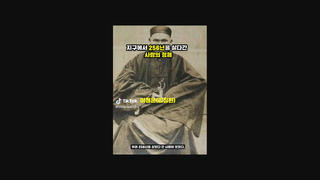
Did Mexico's Congress reveal non-human corpses to the public in September 2023? No, that's not true: The two samples were presented to Mexican lawmakers by a widely-debunked UFO enthusiast, and scientists again voiced skepticism over the alleged remains following the hearing.
The claim appeared in a video (archived here) posted by @lifeszip on TikTok on September 14, 2023. The text in Korean on the video reads, as translated by Lead Stories staff:
Two non-human corpses released by Mexican Congress. The bodies, discovered in Peru in 2017, are 700 and 1,800 years old, and their DNA does not match that of a human..
This is what the post looked like on TikTok at the time of writing:
(Source: TikTok screenshot taken on Tue Oct 10 00:46:39 2023 UTC)
The video refers to snippets from Mexico's first congressional hearing on Unidentified Anomalous Phenomena (UAP) on September 12, 2023, viewable in full in Spanish on Canal del Congreso's YouTube page, which broadcasts congressional sessions.
Jaime Maussan, who describes himself as a ufologist and does not hold any position in Congress, began presenting the alleged non-human remains inside caskets at the 2:28:35 timestamp.
The two bodies, allegedly found in Peru in 2017, were small specimens with elongated heads and three fingers, and Maussan claimed carbon dating analysis conducted by researchers at the National Autonomous University of Mexico (UNAM) determined that the non-human remains were around 1,000 years old.
Members of UNAM's National Laboratory of Mass Spectrometry with Accelerators (LEMA), which conducted the carbon study mentioned during Maussan's presentation, refuted his claim just one day following the hearing in a republished statement from 2017. The statement noted that the carbon dating analysis studied skin and brain tissue samples, not the full specimens, in May 2017 and only determined the age of the samples and did not draw any conclusions on the origin of the samples.
Julieta Fierro, a scientist at UNAM, said scientists would require advanced technology other than carbon-14 dating to determine whether the samples are non-human as claimed by Maussan, according to the Australian Broadcasting Corporation and The Associated Press.
Fierro reviewed the test results presented at the congressional hearing for Reuters, which reported on September 16 that "the presence of carbon-14 in studies done by UNAM proves that the samples were related to brain and skin tissues from different mummies who died at different times." Fierro was quoted as saying that the results did not "indicate life compounds that do not exit on Earth."
Maussan's claims, along with the specimens presented to Mexican lawmakers, are not new. He had previously presented "mummies" found near Nazca in 2017. He was involved with a website called "The Alien Project" where such alleged remains were "discovered" in Nazca. In 2017, he participated in a film on the mummies, titled "Unearthing Nazca," for Gaia.com.
In a Sept. 16 article on the origins of the alleged non-human remains presented by Maussan, Vox reported that "The Alien Project" started as a crowdfunding campaign that led to a team of self-titled experts giving credence to the widely-discredited specimens:
The full picture includes a long lineup of skeevy con men dedicated to passing themselves off as pseudoscientific 'experts,' from media veterans to fake archaeologists and doctors with dubious degrees -- all committed to insisting (even as a litany of real scientists line up to object) that their fake aliens are real.
Previous specimens presented by Maussan were found to be manipulated human or animal remains, as laid out by The Atlantic and Live Science. A study published in the International Journal of Biology and Biomedicine analyzed the skull of one of the specimen using CT scans:
It was shown that the head of the small body is largely made of a deteriorated llama braincase and other unidentified bones, and greatly resembles the human cranium.
Rodolfo Salas-Gismondi, who leads the Vertebrate Paleontology Department at the Museo de Historia Natural in Lima and a research associate at the American Museum of Natural History in New York, also analyzed the hands of the various remains of "mummies" in 2017. He expressed skepticism on Maussan and his team of researchers' knowledge of human anatomy, arguing that the long, thin fingers on the hands of the alleged remains were made of various human bones arranged together.
More reporting on the alleged non-human remains and Maussan's previously discredited claims can be read on Smithsonian Magazine, Sky News and Forbes.














